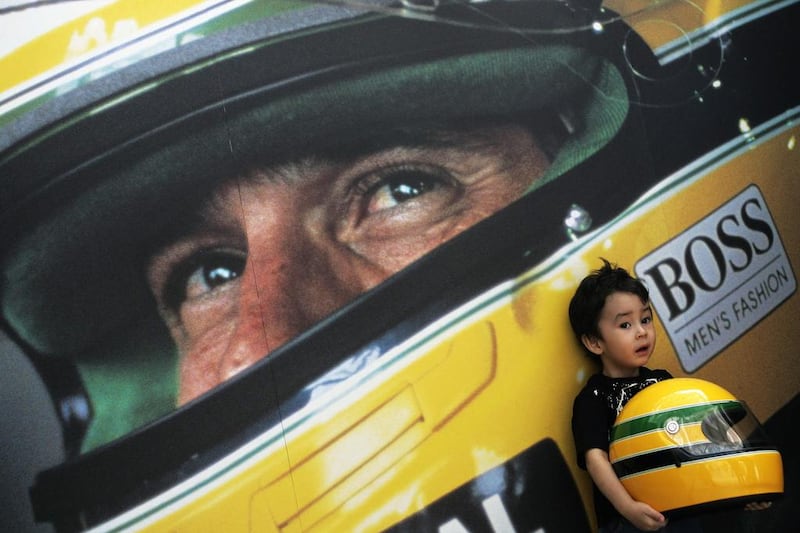Six of Ayrton Senna’s best F1 performances
1984 Monaco Grand Prix
In his debut season in Formula One, Senna made a statement of intent on what he would achieve in the sport as he finished second in the Monaco Grand Prix in the uncompetitive Toleman. Senna thrived, as would so often be the case in wet conditions, as he charged through from 13th on the grid. Conditions were judged too wet in Monte Carlo and the race was red flagged on lap 32, with Senna passing Alain Prost’s McLaren just before the red flag was thrown to stop the race. The race was not restarted, but controversially the results were taken from lap 31, keeping Prost in front. But though he had not won, Senna had demonstrated what a force he would be in the coming years.
1985 Portuguese Grand Prix
The first of Senna’s 41 wins in F1 was one of his more dominant as he finished a minute ahead of second-placed Michele Alboreto in Estoril. Heavy rain left lots of standing water on the track, but it did not faze Senna as he streaked away in his Lotus, going more than a second a lap faster than anyone else, and he probably would have lapped Alboreto, the only man to finish on the same lap, had he not eased off in the closing stages to ensure his victory.
1988 Japanese Grand Prix
1988 was Senna’s first year with a championship winning car at his disposal as he drove for McLaren, and he took full advantage of it as he and teammate Alain Prost dominated the season, winning 13 of the first 14 races. Senna could win his first world title in Japan if he triumphed, but that did not appear probable initially as he bogged down badly at the start, dropping from first to 13th at the first corner. But the Brazilian disproved the theory it was hard to pass at Suzuka as he charged through the field inside 27 laps, passing Prost on the start/finish straight at the start of lap 27. He cruised on to claim the win and the first of his three world titles.
1991 Brazilian Grand Prix
By now a double world champion, the one thing missing from the Brazilian’s trophy cabinet was a victory on home soil in front of his devoted compatriots. After missing out on the seven previous occasions it looked as if it would be different in 1991. He led from pole position, and when nearest challenger Nigel Mansell retired with a gearbox failure the elusive win appeared to be his for the taking. But then the gearbox in Senna’s McLaren began misfiring, slowly losing gears until he was stuck with only sixth gear. To compound things further it had also began to rain in Sao Paulo, but Senna gamely held on, hustling his crippled car around Interlagos, and took the chequered flag to the joy of his fans. Such was the effort it had taken out of Senna, he needed immediate medical attention post-race, suffering badly from cramp to his shoulders.
1992 Monaco Grand Prix
A three-time world champion by this point, 1992 was a difficult year for Senna as the McLaren was no match for the speed of Nigel Mansell’s, which had been boosted by the revolutionary active suspension. Mansell had won the first five races, and looked as if it would be six in Monaco when he led comfortably. Senna, to his credit, kept pushing, going with the ethos that anything can happen on the tight streets of Monte Carlo, and he was rewarded for staying within 30 seconds of Mansell when the Briton was forced to make a pit stop seven laps from the end as he suspected he had a puncture. Senna now had the lead, but had Mansell quickly on his tail, on considerably fresher tyres and a much faster car. Superb car placement and timing his exits from each corner to perfection ensured Senna kept Mansell behind him to the finish line for the fifth of his record six successes in the principality.
1993 European Grand Prix
It was wet again for the race at Donington Park, giving Senna another opportunity to show off his skills in a car that normally was no match for the Williams machines. Falling to fifth off the start, Senna gave a masterclass in wet-race driving as before the end of the lap he had taken the lead, passing Michael Schumacher, Karl Wendlinger, Damon Hill and then Prost. He went on to dominate the race and win by more a minute in his McLaren, but typically of the Brazilian he had been unfussed by his effort, believing the car was easy in the wet thanks to gizmos such as traction control, putting his win in Portugal in 1985 as a higher achievement.





